Ithaca/Enfield (June 18)
Traveling from 1000 Islands to Ithaca should be straightward. We crossed the 1000 Islands bridges and got directly onto I81. However, Ithaca is not on a major highway and we had to meander on smaller roads to get to our campsite near Robert H. Treman Park. (We might have preferred to stay at one of Ithaca’s 3 state parks, but we made the reservation before we learned the deficiencies of the on-line system. ) Although we were not in the park, the Finger Lakes Trail borders the campground.
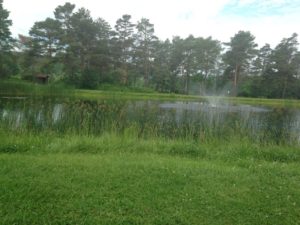 Our campsite was right beside the campground pond. I expected to hear the same melodious frog sounds I heard on Wellesley Island. However, this pond is filled with bull frogs, which call all night and most of the day, filling the campground with load croaks that sound like fog horns (and are almost as loud).
Our campsite was right beside the campground pond. I expected to hear the same melodious frog sounds I heard on Wellesley Island. However, this pond is filled with bull frogs, which call all night and most of the day, filling the campground with load croaks that sound like fog horns (and are almost as loud).
This is a big birding area. Several of the more permanent campsites had feeders, and we found a branch for ours as well. We filled the feeder with freshly purchased bird food, and were very soon rewarded with exactly what was promised on the bag: cardinals, blue jays, rosy grosbeaks, several types of woodpeckers and finches, as well as birds not listed: a large number of redwing blackbirds (visiting from the pond) and various types of sparrows (which we cannot yet tell apart).
The weather was very hot and muggy when we arrived. It was not surprising that a major thunderstorm hit that night, with impressively high winds. However, we were secure in the RV.
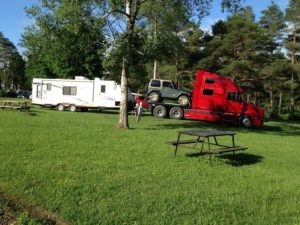 Chuck is still “RV watching” as there are many different combinations of vehicles. He was intrigued by this rig – the cab of a big transport truck, carrying a jeep and pulling a full-sized travel trailer.
Chuck is still “RV watching” as there are many different combinations of vehicles. He was intrigued by this rig – the cab of a big transport truck, carrying a jeep and pulling a full-sized travel trailer.
On Monday we headed into town, planning to go to Stewart Park, drive by our former house, etc. However, when we reached downtown, our tire pressure gauge was complaining about low pressure. A quick check at a service station showed that it was the new tire which replaced our flat in Boston! This time, however, our problem occurred at mid-day, with lots of options for service. We pulled into a place on Rte 13 to see what could be done.
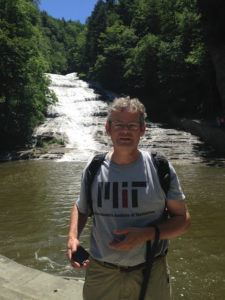 Having learned that would we have to wait at least a couple of hours for service, we decided to pick up fast food for lunch and hike a mile to Buttermilk Falls State Park, which is just south of town.
Having learned that would we have to wait at least a couple of hours for service, we decided to pick up fast food for lunch and hike a mile to Buttermilk Falls State Park, which is just south of town.
As the T-shirt says: “Ithaca is Gorges”. Buttermilk Falls is just a sample of the 4 major gorges/waterfalls in the area.
When the kids were very young they were in Sue’s daycare, which is only a couple of blocks from the Falls. 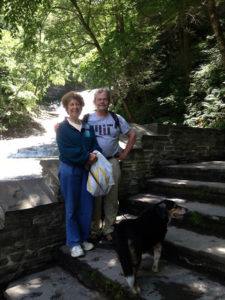 On nice afternoons in the summer, Sue would transport the kids to the park and do pick-up from there. It is such a lovely spot that we started packing supper and having a picnic most evenings. So our picnic lunch at the park was both scenic and nostalgic. We also hiked much of the trail that goes along the falls to the upper park. I cannot say I recall ever visiting the upper park. This time, just as we were about to emerge at the top, we got the call that the tire had been repaired.
On nice afternoons in the summer, Sue would transport the kids to the park and do pick-up from there. It is such a lovely spot that we started packing supper and having a picnic most evenings. So our picnic lunch at the park was both scenic and nostalgic. We also hiked much of the trail that goes along the falls to the upper park. I cannot say I recall ever visiting the upper park. This time, just as we were about to emerge at the top, we got the call that the tire had been repaired.
Fortunately, the tire could be patched. Fixing the tire was enough excitement for one day. We went grocery shopping and then back to the campsite.
Tuesday, as usual, was a work day, and we did not do much else.
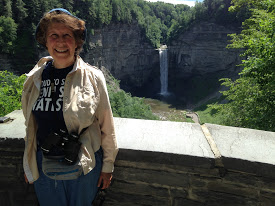
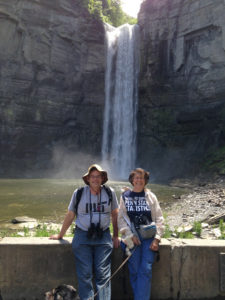 Wednesday we headed out to Taughannock Falls State Park – another waterfall hike. The river has cut a very deep gorge – up to 400 feet deep in some spots – and we did a large loop at the top of the gorge rim, as well as a walk along the river bed to the falls and back. We also took a side trip to the shore of Cayuga Lake.
Wednesday we headed out to Taughannock Falls State Park – another waterfall hike. The river has cut a very deep gorge – up to 400 feet deep in some spots – and we did a large loop at the top of the gorge rim, as well as a walk along the river bed to the falls and back. We also took a side trip to the shore of Cayuga Lake.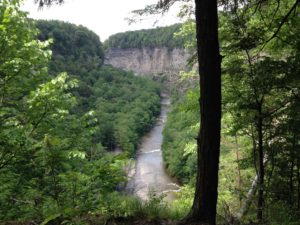 A lot of walking and beautiful scenery was involved. The final climb from the lake to the rim of the canon was a bit much for Rumple, but he did make it.
A lot of walking and beautiful scenery was involved. The final climb from the lake to the rim of the canon was a bit much for Rumple, but he did make it.
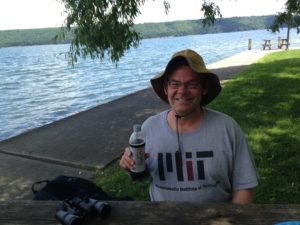
The Cayuga Lake shore.
As we headed back to the campground, our car engine light went on, indicating that the engine was overheating. We pulled into a shopping plaza, and discovered that we had no engine coolant. A kind person stopped to help, and took Chuck to Walmart to buy coolant. (He was on the way to supper with his wife and 2 young kids, so this was particularly kind.) Refilling the tank with coolant allowed us to get back to the campsite, but in the morning the level was down considerably. Since we were headed to State College, we decided to delay repairs until we got home. We were able to keep using the car by refilling the coolant tank twice daily.
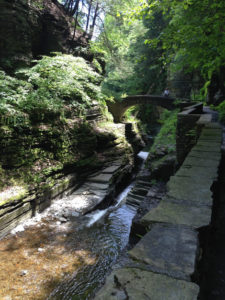 On Thursday we went to Robert H. Treman State Park and walked its gorge trail. It is quite lovely – very similar to Watkins Glen, which for some reason is more famous. It has 3 waterfalls, one of which empties into a lovely swimming area (which was under renovation when we visited).
On Thursday we went to Robert H. Treman State Park and walked its gorge trail. It is quite lovely – very similar to Watkins Glen, which for some reason is more famous. It has 3 waterfalls, one of which empties into a lovely swimming area (which was under renovation when we visited). 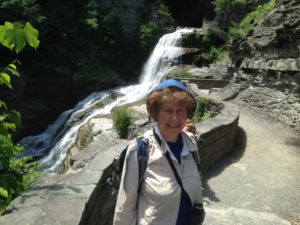 Since then there has been a lot of rain, which does not bode well for the renovation. See video on the Robert H. Treman Park facebook page https://www.facebook.com/204962196191935/videos/vb.204962196191935/1569588749729266/?type=2&theater)
Since then there has been a lot of rain, which does not bode well for the renovation. See video on the Robert H. Treman Park facebook page https://www.facebook.com/204962196191935/videos/vb.204962196191935/1569588749729266/?type=2&theater)
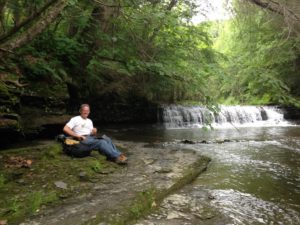
In the evening we went to Ithaca Commons and met our friend Gale for dinner. I have been friends with Gale’s husband, Joe since our undergraduate days in mathematics at U. of Toronto (1971?) and I have known Gale since I stayed with them on a trip to California that led to my going to graduate school (around 1983). They moved to Ithaca a few years after we did, and their two older kids were in Jonathan’s classes in elementary school. Unfortunately, everyone but Gale and younger son Daniel were out of town.
For dinner we had “Chinese tapas” on Ithaca Commons. This idea, which we had encountered in Toronto, has not yet made it to State College, but it should. The idea is to order many small plates of food which can be shared or hogged. This gives even greater variety than the usual family-style Chinese meal, and is similar to the banquets I enjoyed in Beijing.
For dessert we moved to another place that I think had just opened when we left Ithaca. (Due to the Cornell Hotel School, Ithaca has a fluid restaurant scene – only a few of our old favorites, including, of course, Moosewood, are still operating.) We ended the evening at Gale’s house, so we could visit with Daniel, who had been at work during dinnertime.
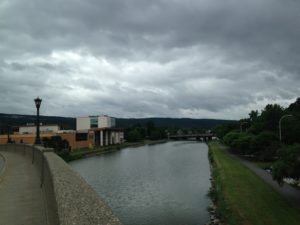 On Friday we took a day to visit friends. Chuck met his friend John, with whom he used to work, and I met with Bonnie, who has also moved away, but visits Ithaca frequently and happened to be there when we were. While waiting for Chuck to finish up, I also took a quick bike ride on the new trails that go along the flood canals.
On Friday we took a day to visit friends. Chuck met his friend John, with whom he used to work, and I met with Bonnie, who has also moved away, but visits Ithaca frequently and happened to be there when we were. While waiting for Chuck to finish up, I also took a quick bike ride on the new trails that go along the flood canals.
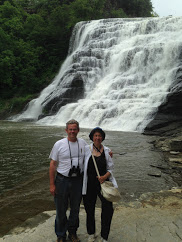 After lunch we visited some of our old haunts. We started with Ithaca Falls, which is very close to the high school and our old house. The falls used to be completely unmarked, and reached by a poor (although very short) trail. Now there is a small park , parking and a proper path. (Whether all of this still exist 3 weeks later, as I write, is dubious due to several torrential rainfalls. Here is a link to a recently posted video. https://www.youtube.com/watch?v=5Mosp4eaaiY) In any case, the falls were in their full glory for our visit.
After lunch we visited some of our old haunts. We started with Ithaca Falls, which is very close to the high school and our old house. The falls used to be completely unmarked, and reached by a poor (although very short) trail. Now there is a small park , parking and a proper path. (Whether all of this still exist 3 weeks later, as I write, is dubious due to several torrential rainfalls. Here is a link to a recently posted video. https://www.youtube.com/watch?v=5Mosp4eaaiY) In any case, the falls were in their full glory for our visit.
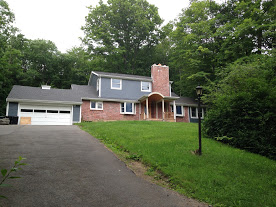 We then went to our old house (improved by the addition of a much-needed front porch). Can you believe that this beautiful stream was on the boundary of our property.
We then went to our old house (improved by the addition of a much-needed front porch). Can you believe that this beautiful stream was on the boundary of our property.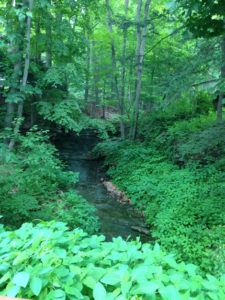 ? Elisabeth and her friends Kerri and Monika used to turn over the stones to look for salamanders. Our backyard was also the favorite grazing spot for a herd of about 20 deer. (There is no backyard in Ithaca that was not the grazing spot of at least a few deer.) I had a substantial vegetable garden which had been put in by the former owner of the house, a retired farmer. He had an electric fence, but after electrocuting a squirrel, I decided to protect my veggies with a 7 foot wire fence – and that was frequently breeched. (No chance to peek in the backyard to see what the new owners did to the substantial yard.)
? Elisabeth and her friends Kerri and Monika used to turn over the stones to look for salamanders. Our backyard was also the favorite grazing spot for a herd of about 20 deer. (There is no backyard in Ithaca that was not the grazing spot of at least a few deer.) I had a substantial vegetable garden which had been put in by the former owner of the house, a retired farmer. He had an electric fence, but after electrocuting a squirrel, I decided to protect my veggies with a 7 foot wire fence – and that was frequently breeched. (No chance to peek in the backyard to see what the new owners did to the substantial yard.)
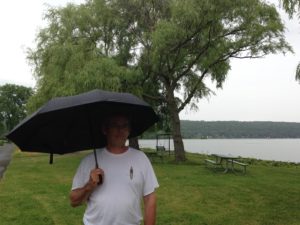 We also visited Stewart Park, on the end of Cayuga Lake, with magnificent old weeping willows (many of which had to be replaced during our time in Ithaca, because they do get old and more vulnerable to the wind).
We also visited Stewart Park, on the end of Cayuga Lake, with magnificent old weeping willows (many of which had to be replaced during our time in Ithaca, because they do get old and more vulnerable to the wind). 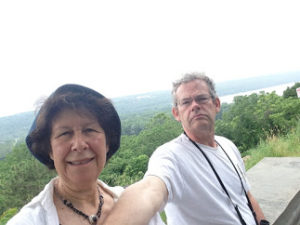 We also went to Sunset Park, which is near our old house – tiny but with an impressive view of the lake.
We also went to Sunset Park, which is near our old house – tiny but with an impressive view of the lake.
Finally we went out to the Cornell Lab of Ornithology. I took a very nice sabbatical there, studying whale vocalizations in the Bioacoustics Lab. I had a little slice of window, overlooking the main pond and a bunch of bird feeders (with an amusing set of visitors including birds, squirrels and raccoons). We took the main hike around the pond (despite some rain) but unfortunately the new lab building, which was in the planning stages when we left, was already closed.
One interesting feature of the hike were tiny frogs, about the size of my pinkie fingernail, which were hopping across the paths. A google search revealed that these are baby toads. Apparently baby frogs avoid being eaten by aquatic predators by growing quickly into big tadpoles, while baby toads avoid being eaten by aquatic predators by metamorphizing into tiny toads and getting out of the water. Neither of us had ever seen these babies before, so we must have been there at just the right time when they left the water looking for hiding spots.
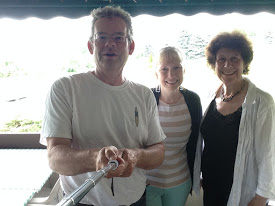 For our dinner we met up with our friend Sandy (mother of Kerri and Monika) at the Sunset Cafe, near Ithaca College.
For our dinner we met up with our friend Sandy (mother of Kerri and Monika) at the Sunset Cafe, near Ithaca College.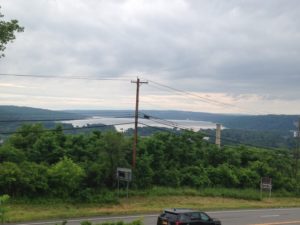 This offers a wonderful view over the lake. We had been out of touch with Sandy since Elisabeth’s bat mitzvah (11 years ago) so there was a lot of catching up to do.
This offers a wonderful view over the lake. We had been out of touch with Sandy since Elisabeth’s bat mitzvah (11 years ago) so there was a lot of catching up to do.
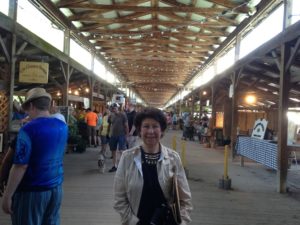 On Saturday morning we parked at Stewart Park and rode our bikes to Ithaca Framers’ Market to meet Gale for brunch. Ithaca Farmers’ Market is more like a city market than a small town farmers’ market, with a lot of prepared foods, handicrafts, and music, along with a few farm vendors. When we lived in Ithaca, it was THE place I liked to take the kids on the weekend – we would buy some snacks and fruit, climb the willow trees on the flood canals, feed the ducks and listen to live music, as well as seeing friends. Many of my favorite vendors are still there, along with the trees and the ducks. There seemed to be a bit less music, but we were at the exact right distance to enjoy the music from the festival that was taking place at Stewart Park.
On Saturday morning we parked at Stewart Park and rode our bikes to Ithaca Framers’ Market to meet Gale for brunch. Ithaca Farmers’ Market is more like a city market than a small town farmers’ market, with a lot of prepared foods, handicrafts, and music, along with a few farm vendors. When we lived in Ithaca, it was THE place I liked to take the kids on the weekend – we would buy some snacks and fruit, climb the willow trees on the flood canals, feed the ducks and listen to live music, as well as seeing friends. Many of my favorite vendors are still there, along with the trees and the ducks. There seemed to be a bit less music, but we were at the exact right distance to enjoy the music from the festival that was taking place at Stewart Park.
John had invited us to visit him at home, so that was our next stop. Like Chuck, he is a software engineer. However, he has a very active hobby handcrafting guitars. We toured his workshop and learned quite a bit about how a guitar is put together, and what to look for in terms of sound. We did not hear him play any of his creations, but he gave us a CD he had recorded which we are enjoying when we drive. We were very impressed by the craftmanship in the guitars, including a lot of inlay work. As well, his wife Joanne is a fine quilter. We enjoyed our visit and were very impressed by their skills.
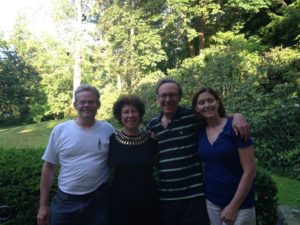 From there we headed off to visit our friends David and Lisa, who had just returned from a trip to Madagascar. (David is an international economist, and spends a lot of time in Africa.) They seem to have had a fascinating trip, and it was good to catch up with them. As well, their youngest daughter, Emma, returned from a trip to Europe during our visit. We last saw Emma when she was about 8, so seeing her as a recent high school graduate was very nice. The two older kids, Alexander and Lily, who were in elementary school with our kids being almost exactly the same age, are (of course) off doing their own thing.
From there we headed off to visit our friends David and Lisa, who had just returned from a trip to Madagascar. (David is an international economist, and spends a lot of time in Africa.) They seem to have had a fascinating trip, and it was good to catch up with them. As well, their youngest daughter, Emma, returned from a trip to Europe during our visit. We last saw Emma when she was about 8, so seeing her as a recent high school graduate was very nice. The two older kids, Alexander and Lily, who were in elementary school with our kids being almost exactly the same age, are (of course) off doing their own thing.
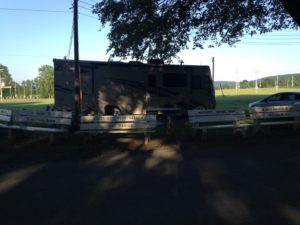 We pulled into the Grange Fairgrounds in the early afternoon, and were soon met by Ryan Frankhauser, the organizer of the Bluegrass Festival. Although camping was not supposed to start until the 2nd, and the festival itself not until the afternoon of the 5th, there were already quite a few campers set up. We selected a shady site close to the main gate – no sewer, but close to the showers and bathroom.
We pulled into the Grange Fairgrounds in the early afternoon, and were soon met by Ryan Frankhauser, the organizer of the Bluegrass Festival. Although camping was not supposed to start until the 2nd, and the festival itself not until the afternoon of the 5th, there were already quite a few campers set up. We selected a shady site close to the main gate – no sewer, but close to the showers and bathroom.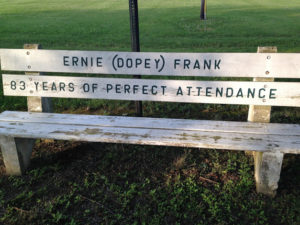 One of the interesting features of the Grange Fairground are the benches. Each has been donated – some by businesses but most as memorials to special occasions or special people. This last idea makes great sense to me.
One of the interesting features of the Grange Fairground are the benches. Each has been donated – some by businesses but most as memorials to special occasions or special people. This last idea makes great sense to me. 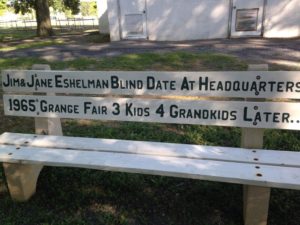 How comforting to sit on a bench in a location where one made happy memories with someone, and think of that person. Since many local families have been attending the fair for generations, and family members come from all over the world to attend the fair, this is a much more meaningful memorial than a gravesite visit. I selected one of these benches for the blog because it shows the kind of devotion that local families have to the Grange Fair. I selected the other because it shows how much the fair is part of local life and culture.
How comforting to sit on a bench in a location where one made happy memories with someone, and think of that person. Since many local families have been attending the fair for generations, and family members come from all over the world to attend the fair, this is a much more meaningful memorial than a gravesite visit. I selected one of these benches for the blog because it shows the kind of devotion that local families have to the Grange Fair. I selected the other because it shows how much the fair is part of local life and culture.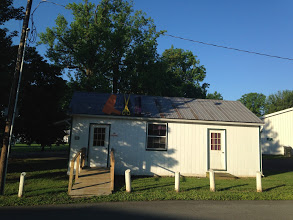 The Grange Fair itself lasts for 10 days at the end of August. At that time, the fairgrounds become a village with thousands of permanent residents (1500 tents and 1500 RVs) and many services. This is the hairdressing salon, waiting for August.
The Grange Fair itself lasts for 10 days at the end of August. At that time, the fairgrounds become a village with thousands of permanent residents (1500 tents and 1500 RVs) and many services. This is the hairdressing salon, waiting for August.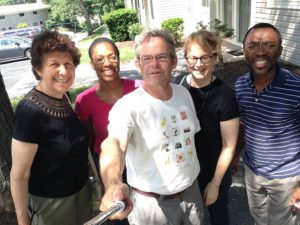 July 2 was the official start of camping for the Bluegrass Festival and the place began to fill up. However, we arranged to go to Harrisburg with friends Don and Mindy to visit Don’s daughter Suzanne.
July 2 was the official start of camping for the Bluegrass Festival and the place began to fill up. However, we arranged to go to Harrisburg with friends Don and Mindy to visit Don’s daughter Suzanne.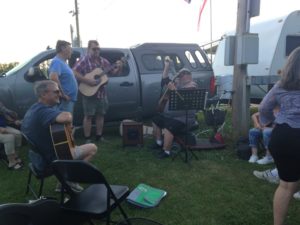 When we got back to the campsite after our visit with Suzanne, we found that campers were already organizing jam sessions. We went to a session with many musicians organized by our neighbor on the other side, Tom. People seem to have got to know one another through many years of meeting at bluegrass events. The talent was pretty amazing – these were just the audience, not the performers.
When we got back to the campsite after our visit with Suzanne, we found that campers were already organizing jam sessions. We went to a session with many musicians organized by our neighbor on the other side, Tom. People seem to have got to know one another through many years of meeting at bluegrass events. The talent was pretty amazing – these were just the audience, not the performers.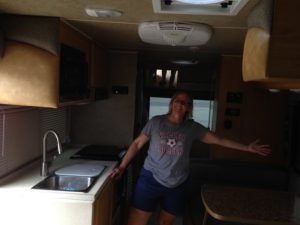 We had been getting calls from Chuck’s sister Karen. She just bought an RV in California, and was in the process of driving it home to Connecticut. On the 3rd, she was toodling along I80, which passes right by State College. We arranged to meet her in the Lamar truck stop, to see the new RV. We will be camping with her and other family members at the end of August. (No Grange Fair for us – but that is OK as there is absolutely no way to get a campsite at the fair.)
We had been getting calls from Chuck’s sister Karen. She just bought an RV in California, and was in the process of driving it home to Connecticut. On the 3rd, she was toodling along I80, which passes right by State College. We arranged to meet her in the Lamar truck stop, to see the new RV. We will be camping with her and other family members at the end of August. (No Grange Fair for us – but that is OK as there is absolutely no way to get a campsite at the fair.)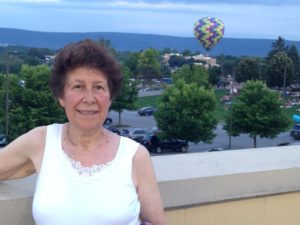 We always go to the fireworks, and I like to get as close as possible. If my stomach does not vibrate at each blast, we are not close enough. The town always has a festival, and this time this local hot air balloon, which frequently sails over our house, was there to give tethered rides. This year’s display was excellent. As well, there was a spectacular sunset
We always go to the fireworks, and I like to get as close as possible. If my stomach does not vibrate at each blast, we are not close enough. The town always has a festival, and this time this local hot air balloon, which frequently sails over our house, was there to give tethered rides. This year’s display was excellent. As well, there was a spectacular sunset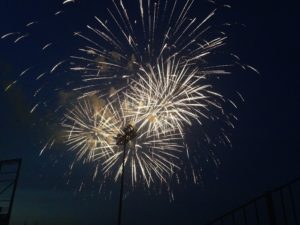
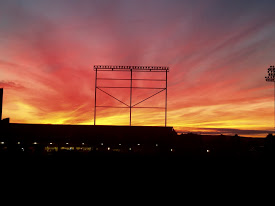
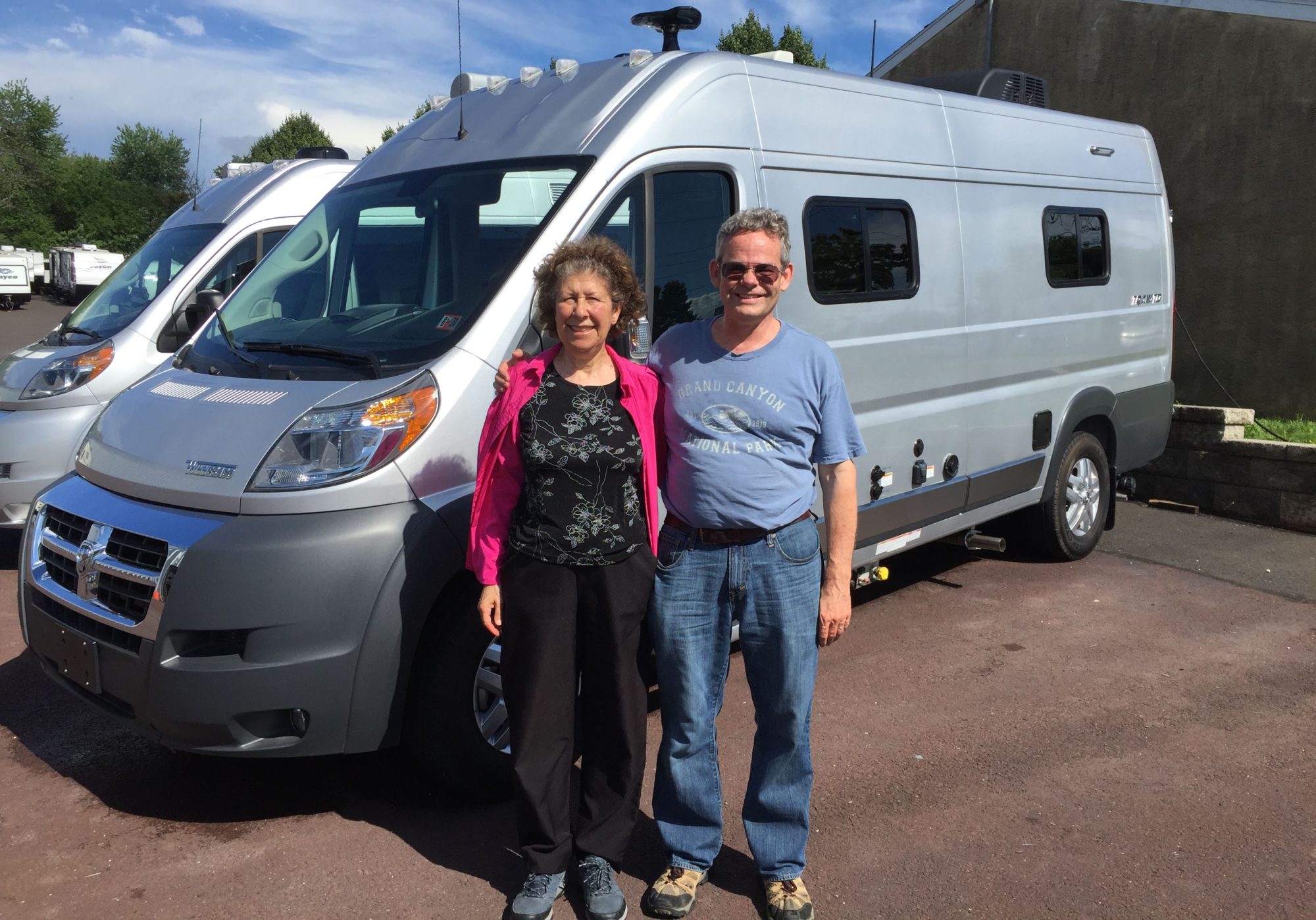
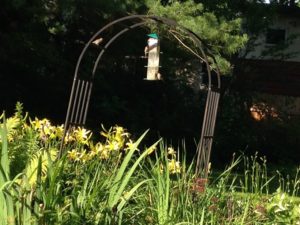 Most of the week was spent doing practical stuff around the house, or just enjoying being home. I put up the bird feeder, and was pleased to find that our yard attracts a variety of birds, including a humming bird. I was surprised at just how quickly my flower beds had become completely overgrown with weeds. I seldom spend a lot of time weeding, but I guess pulling a few each day keeps then down when we are home. I was pleased, however, that I was able to enjoy garlic and kale from the garden, so that I got to enjoy some of my summer bounty.
Most of the week was spent doing practical stuff around the house, or just enjoying being home. I put up the bird feeder, and was pleased to find that our yard attracts a variety of birds, including a humming bird. I was surprised at just how quickly my flower beds had become completely overgrown with weeds. I seldom spend a lot of time weeding, but I guess pulling a few each day keeps then down when we are home. I was pleased, however, that I was able to enjoy garlic and kale from the garden, so that I got to enjoy some of my summer bounty.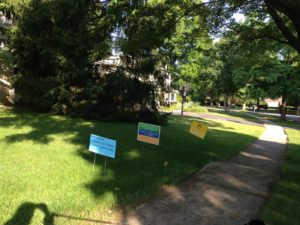 State College has sprouted lawn signs. When I left, quite a few people had signs supporting inclusiveness – our nice protest at the current state of the government. To this have been added signs protesting development of land on the watershed for more housing.
State College has sprouted lawn signs. When I left, quite a few people had signs supporting inclusiveness – our nice protest at the current state of the government. To this have been added signs protesting development of land on the watershed for more housing. Our campsite was right beside the campground pond. I expected to hear the same melodious frog sounds I heard on Wellesley Island. However, this pond is filled with bull frogs, which call all night and most of the day, filling the campground with load croaks that sound like fog horns (and are almost as loud).
Our campsite was right beside the campground pond. I expected to hear the same melodious frog sounds I heard on Wellesley Island. However, this pond is filled with bull frogs, which call all night and most of the day, filling the campground with load croaks that sound like fog horns (and are almost as loud). Chuck is still “RV watching” as there are many different combinations of vehicles. He was intrigued by this rig – the cab of a big transport truck, carrying a jeep and pulling a full-sized travel trailer.
Chuck is still “RV watching” as there are many different combinations of vehicles. He was intrigued by this rig – the cab of a big transport truck, carrying a jeep and pulling a full-sized travel trailer. Having learned that would we have to wait at least a couple of hours for service, we decided to pick up fast food for lunch and hike a mile to Buttermilk Falls State Park, which is just south of town.
Having learned that would we have to wait at least a couple of hours for service, we decided to pick up fast food for lunch and hike a mile to Buttermilk Falls State Park, which is just south of town. On nice afternoons in the summer, Sue would transport the kids to the park and do pick-up from there. It is such a lovely spot that we started packing supper and having a picnic most evenings. So our picnic lunch at the park was both scenic and nostalgic. We also hiked much of the trail that goes along the falls to the upper park. I cannot say I recall ever visiting the upper park. This time, just as we were about to emerge at the top, we got the call that the tire had been repaired.
On nice afternoons in the summer, Sue would transport the kids to the park and do pick-up from there. It is such a lovely spot that we started packing supper and having a picnic most evenings. So our picnic lunch at the park was both scenic and nostalgic. We also hiked much of the trail that goes along the falls to the upper park. I cannot say I recall ever visiting the upper park. This time, just as we were about to emerge at the top, we got the call that the tire had been repaired.
 Wednesday we headed out to Taughannock Falls State Park – another waterfall hike. The river has cut a very deep gorge – up to 400 feet deep in some spots – and we did a large loop at the top of the gorge rim, as well as a walk along the river bed to the falls and back. We also took a side trip to the shore of Cayuga Lake.
Wednesday we headed out to Taughannock Falls State Park – another waterfall hike. The river has cut a very deep gorge – up to 400 feet deep in some spots – and we did a large loop at the top of the gorge rim, as well as a walk along the river bed to the falls and back. We also took a side trip to the shore of Cayuga Lake. A lot of walking and beautiful scenery was involved. The final climb from the lake to the rim of the canon was a bit much for Rumple, but he did make it.
A lot of walking and beautiful scenery was involved. The final climb from the lake to the rim of the canon was a bit much for Rumple, but he did make it.
 On Thursday we went to Robert H. Treman State Park and walked its gorge trail. It is quite lovely – very similar to Watkins Glen, which for some reason is more famous. It has 3 waterfalls, one of which empties into a lovely swimming area (which was under renovation when we visited).
On Thursday we went to Robert H. Treman State Park and walked its gorge trail. It is quite lovely – very similar to Watkins Glen, which for some reason is more famous. It has 3 waterfalls, one of which empties into a lovely swimming area (which was under renovation when we visited).  Since then there has been a lot of rain, which does not bode well for the renovation. See video on the Robert H. Treman Park facebook page https://www.facebook.com/204962196191935/videos/vb.204962196191935/1569588749729266/?type=2&theater)
Since then there has been a lot of rain, which does not bode well for the renovation. See video on the Robert H. Treman Park facebook page https://www.facebook.com/204962196191935/videos/vb.204962196191935/1569588749729266/?type=2&theater)
 On Friday we took a day to visit friends. Chuck met his friend John, with whom he used to work, and I met with Bonnie, who has also moved away, but visits Ithaca frequently and happened to be there when we were. While waiting for Chuck to finish up, I also took a quick bike ride on the new trails that go along the flood canals.
On Friday we took a day to visit friends. Chuck met his friend John, with whom he used to work, and I met with Bonnie, who has also moved away, but visits Ithaca frequently and happened to be there when we were. While waiting for Chuck to finish up, I also took a quick bike ride on the new trails that go along the flood canals. After lunch we visited some of our old haunts. We started with Ithaca Falls, which is very close to the high school and our old house. The falls used to be completely unmarked, and reached by a poor (although very short) trail. Now there is a small park , parking and a proper path. (Whether all of this still exist 3 weeks later, as I write, is dubious due to several torrential rainfalls. Here is a link to a recently posted video. https://www.youtube.com/watch?v=5Mosp4eaaiY) In any case, the falls were in their full glory for our visit.
After lunch we visited some of our old haunts. We started with Ithaca Falls, which is very close to the high school and our old house. The falls used to be completely unmarked, and reached by a poor (although very short) trail. Now there is a small park , parking and a proper path. (Whether all of this still exist 3 weeks later, as I write, is dubious due to several torrential rainfalls. Here is a link to a recently posted video. https://www.youtube.com/watch?v=5Mosp4eaaiY) In any case, the falls were in their full glory for our visit. We then went to our old house (improved by the addition of a much-needed front porch). Can you believe that this beautiful stream was on the boundary of our property.
We then went to our old house (improved by the addition of a much-needed front porch). Can you believe that this beautiful stream was on the boundary of our property.
 We also visited Stewart Park, on the end of Cayuga Lake, with magnificent old weeping willows (many of which had to be replaced during our time in Ithaca, because they do get old and more vulnerable to the wind).
We also visited Stewart Park, on the end of Cayuga Lake, with magnificent old weeping willows (many of which had to be replaced during our time in Ithaca, because they do get old and more vulnerable to the wind).  We also went to Sunset Park, which is near our old house – tiny but with an impressive view of the lake.
We also went to Sunset Park, which is near our old house – tiny but with an impressive view of the lake. For our dinner we met up with our friend Sandy (mother of Kerri and Monika) at the Sunset Cafe, near Ithaca College.
For our dinner we met up with our friend Sandy (mother of Kerri and Monika) at the Sunset Cafe, near Ithaca College. This offers a wonderful view over the lake. We had been out of touch with Sandy since Elisabeth’s bat mitzvah (11 years ago) so there was a lot of catching up to do.
This offers a wonderful view over the lake. We had been out of touch with Sandy since Elisabeth’s bat mitzvah (11 years ago) so there was a lot of catching up to do. On Saturday morning we parked at Stewart Park and rode our bikes to Ithaca Framers’ Market to meet Gale for brunch. Ithaca Farmers’ Market is more like a city market than a small town farmers’ market, with a lot of prepared foods, handicrafts, and music, along with a few farm vendors. When we lived in Ithaca, it was THE place I liked to take the kids on the weekend – we would buy some snacks and fruit, climb the willow trees on the flood canals, feed the ducks and listen to live music, as well as seeing friends. Many of my favorite vendors are still there, along with the trees and the ducks. There seemed to be a bit less music, but we were at the exact right distance to enjoy the music from the festival that was taking place at Stewart Park.
On Saturday morning we parked at Stewart Park and rode our bikes to Ithaca Framers’ Market to meet Gale for brunch. Ithaca Farmers’ Market is more like a city market than a small town farmers’ market, with a lot of prepared foods, handicrafts, and music, along with a few farm vendors. When we lived in Ithaca, it was THE place I liked to take the kids on the weekend – we would buy some snacks and fruit, climb the willow trees on the flood canals, feed the ducks and listen to live music, as well as seeing friends. Many of my favorite vendors are still there, along with the trees and the ducks. There seemed to be a bit less music, but we were at the exact right distance to enjoy the music from the festival that was taking place at Stewart Park. From there we headed off to visit our friends David and Lisa, who had just returned from a trip to Madagascar. (David is an international economist, and spends a lot of time in Africa.) They seem to have had a fascinating trip, and it was good to catch up with them. As well, their youngest daughter, Emma, returned from a trip to Europe during our visit. We last saw Emma when she was about 8, so seeing her as a recent high school graduate was very nice. The two older kids, Alexander and Lily, who were in elementary school with our kids being almost exactly the same age, are (of course) off doing their own thing.
From there we headed off to visit our friends David and Lisa, who had just returned from a trip to Madagascar. (David is an international economist, and spends a lot of time in Africa.) They seem to have had a fascinating trip, and it was good to catch up with them. As well, their youngest daughter, Emma, returned from a trip to Europe during our visit. We last saw Emma when she was about 8, so seeing her as a recent high school graduate was very nice. The two older kids, Alexander and Lily, who were in elementary school with our kids being almost exactly the same age, are (of course) off doing their own thing.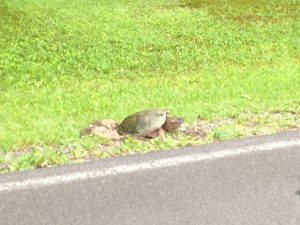 The following morning, Rumple and I went for a lengthy walk along one of the shores and through several of the campgrounds. It is the egg laying season for snapping turtles. The highlight of the walk was watching a large snapping turtle dig a nest by the roadside.
The following morning, Rumple and I went for a lengthy walk along one of the shores and through several of the campgrounds. It is the egg laying season for snapping turtles. The highlight of the walk was watching a large snapping turtle dig a nest by the roadside.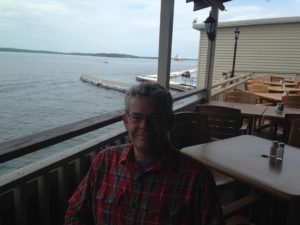 On Saturday we headed off to the mainland to start our boat tour – only to find that the on-line booking system for the tour was also defective. The tour operator decided to give us free tickets for a tour later in the day, and we went into the little town of Clayton for lunch and a walking tour.
On Saturday we headed off to the mainland to start our boat tour – only to find that the on-line booking system for the tour was also defective. The tour operator decided to give us free tickets for a tour later in the day, and we went into the little town of Clayton for lunch and a walking tour. 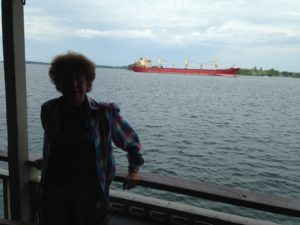 We ate overlooking the St. Lawrence Seaway, and watched a couple of big freighters cruise through. Clayton was having a dog diving competition, and we watched for a while as the dogs jumped into a dockside pool and swam their laps.
We ate overlooking the St. Lawrence Seaway, and watched a couple of big freighters cruise through. Clayton was having a dog diving competition, and we watched for a while as the dogs jumped into a dockside pool and swam their laps.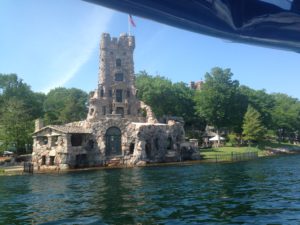 In the afternoon, we boarded our little tour boat and enjoyed a 3 hour cruise around the islands. It is really lovely. Needless to say, there are some huge mansions including Boldt Castle (which can be toured, although we decided not to). The water was very high, and some of the islands had nothing but the cottage or a tree visible. It was a very nice thing to do on a very hot afternoon, and we definitely got a better view of the islands than would be possible by either car or kayak.
In the afternoon, we boarded our little tour boat and enjoyed a 3 hour cruise around the islands. It is really lovely. Needless to say, there are some huge mansions including Boldt Castle (which can be toured, although we decided not to). The water was very high, and some of the islands had nothing but the cottage or a tree visible. It was a very nice thing to do on a very hot afternoon, and we definitely got a better view of the islands than would be possible by either car or kayak.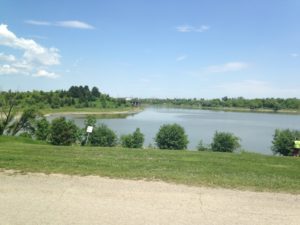 We camped at the Indian Line Recreation Area, at the intersection of 407, 427 and W. Finch. I do not recollect this recreation area from my childhood. However, in the summer of 1975, I took a solo bicycle and camping trip to McMichael gallery, and I must have camped at this spot, as it is the only one in the area. The campground has nothing to offer but campsites, so it is not surprising that we did not take any family trips there. It does sit on the edge of a flood control reservoir, which attracts a lot of birds, but there are no hiking trails, swimming or other recreational activities.
We camped at the Indian Line Recreation Area, at the intersection of 407, 427 and W. Finch. I do not recollect this recreation area from my childhood. However, in the summer of 1975, I took a solo bicycle and camping trip to McMichael gallery, and I must have camped at this spot, as it is the only one in the area. The campground has nothing to offer but campsites, so it is not surprising that we did not take any family trips there. It does sit on the edge of a flood control reservoir, which attracts a lot of birds, but there are no hiking trails, swimming or other recreational activities. I took a daily trip to the house to “supervise” the estate sale (but really to agonize over what she decided to trash without even trying to sell). In the end, the sale was on June 11. We barely cleared the cost of hauling away the trash and things that did not sell and could not be donated. However, the house was very clean when she was done, and I spent only a few hours doing some vacuuming and rolling up a carpet which I decided to save when it did not sell.
I took a daily trip to the house to “supervise” the estate sale (but really to agonize over what she decided to trash without even trying to sell). In the end, the sale was on June 11. We barely cleared the cost of hauling away the trash and things that did not sell and could not be donated. However, the house was very clean when she was done, and I spent only a few hours doing some vacuuming and rolling up a carpet which I decided to save when it did not sell.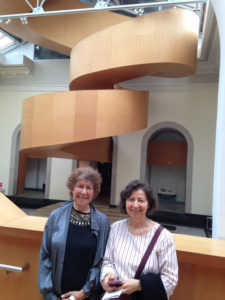 It was not all work. We had two delightful dinners with my friend Susan, and she also took us to the Art Gallery of Ontario (AGO) for the Georgia O’Keefe exhibit. I was shocked to learn that O’Keefe was repelled by the characterization of her work as erotic – even after learning this, I could not help but see all the suggestive holes and passages as female symbols. AGO also has a great collection of Tom Thompson and Group of Seven paintings, and I could have spent more time there.
It was not all work. We had two delightful dinners with my friend Susan, and she also took us to the Art Gallery of Ontario (AGO) for the Georgia O’Keefe exhibit. I was shocked to learn that O’Keefe was repelled by the characterization of her work as erotic – even after learning this, I could not help but see all the suggestive holes and passages as female symbols. AGO also has a great collection of Tom Thompson and Group of Seven paintings, and I could have spent more time there. 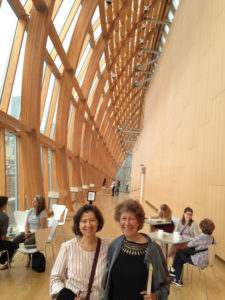 As well, the building has been beautifully renovated since I was last there – we were able to enjoy the renovation while enjoying a snack in the gallery cafe.
As well, the building has been beautifully renovated since I was last there – we were able to enjoy the renovation while enjoying a snack in the gallery cafe.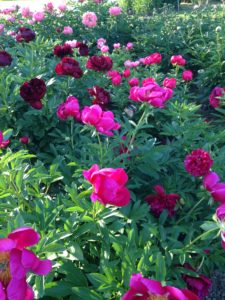
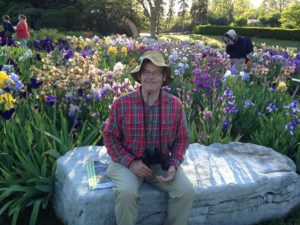
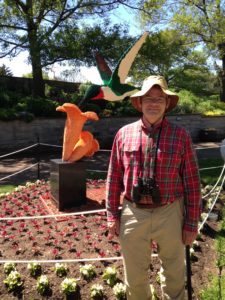
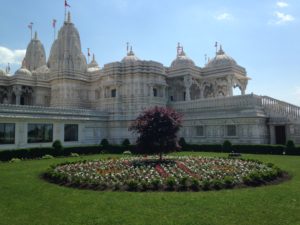 The campground is in a part of Toronto that has a large (Asian) Indian population. Just a few blocks away is the impressive and beautiful BAPS Shri Swaminarayan Mandir, a stunning temple. The entrance area is all intricately carved wood. My photo does not do it justice.
The campground is in a part of Toronto that has a large (Asian) Indian population. Just a few blocks away is the impressive and beautiful BAPS Shri Swaminarayan Mandir, a stunning temple. The entrance area is all intricately carved wood. My photo does not do it justice.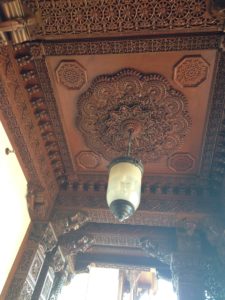 The main temple is a confection of lacey carved marble. (http://www.baps.org/Global-Network/North-America/Toronto/Visitor-Info.aspx). It was carved in India and then shipped piece by piece to Toronto. It is quite an amazing piece of work! Photos are not allowed inside.
The main temple is a confection of lacey carved marble. (http://www.baps.org/Global-Network/North-America/Toronto/Visitor-Info.aspx). It was carved in India and then shipped piece by piece to Toronto. It is quite an amazing piece of work! Photos are not allowed inside. 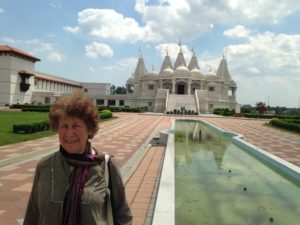
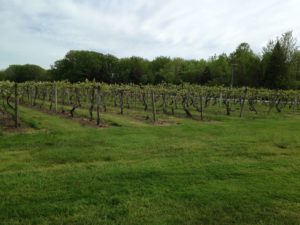 Barcelona, NY (May 21) We are camped on the south shore of Lake Erie. This shore is endless vineyards. I was going to say “wine country” but with the Welch grape juice headquarters just down the road, I will have to say “Concord grape country”.
Barcelona, NY (May 21) We are camped on the south shore of Lake Erie. This shore is endless vineyards. I was going to say “wine country” but with the Welch grape juice headquarters just down the road, I will have to say “Concord grape country”. 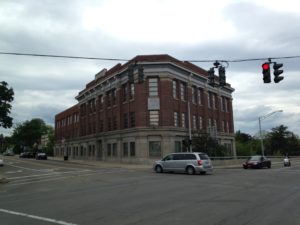 At this time of year, the vines are very pretty. Each gust of wind reveals the delicate pink underside of the leaves, so that it looks like the vines are in bloom, although I am sure that the blossom season is still weeks away.
At this time of year, the vines are very pretty. Each gust of wind reveals the delicate pink underside of the leaves, so that it looks like the vines are in bloom, although I am sure that the blossom season is still weeks away.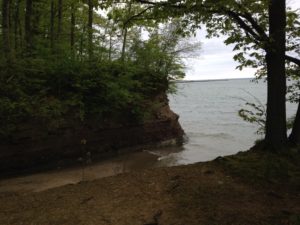 Ottaway Park, across the road from us, is on a small cliff overlooking the lake. One thing I find interesting is that Canadian black squirrels are found in this park, although I have only seen American grey squirrels in the campground. When I first moved to the US, I was amazed by the huge grey squirrels here. In Toronto, the squirrels are small and black.
Ottaway Park, across the road from us, is on a small cliff overlooking the lake. One thing I find interesting is that Canadian black squirrels are found in this park, although I have only seen American grey squirrels in the campground. When I first moved to the US, I was amazed by the huge grey squirrels here. In Toronto, the squirrels are small and black. 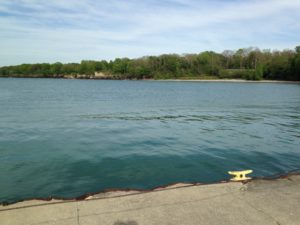 It was only after working at the Lab of Ornithology that I realized that the lakes and the St. Lawrence River provided the geographical isolation that allowed these differences to develop. However, I imagine there are now occasional squirrel crossings on the bridges or by hitchhiking on vehicles, bringing admixture. (I have heard that American grey squirrels have made their way to Europe, with bad consequences for European squirrels. The Great Lakes are formidable barriers, but nothing compared to the north Atlantic.)
It was only after working at the Lab of Ornithology that I realized that the lakes and the St. Lawrence River provided the geographical isolation that allowed these differences to develop. However, I imagine there are now occasional squirrel crossings on the bridges or by hitchhiking on vehicles, bringing admixture. (I have heard that American grey squirrels have made their way to Europe, with bad consequences for European squirrels. The Great Lakes are formidable barriers, but nothing compared to the north Atlantic.)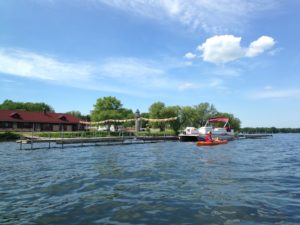 Tuesdays are work days. As a result, we had only a few hours Tuesday afternoon to do any fun activities. We went to Lake Chautauqua, which is just south of us, to go kayaking. We thoroughly enjoyed the paddle around the town of Mayville and the ice cream we had later. We also saw a pair of bald eagles and an osprey. We are giving up on “Rumple the kayak dog” because he was really miserable throughout the trip, even though the water was calm and he was cuddled up with me. However, he did enjoy his share of the ice cream. We never kayak for more than a couple of hours, and he will stay in the RV in future.
Tuesdays are work days. As a result, we had only a few hours Tuesday afternoon to do any fun activities. We went to Lake Chautauqua, which is just south of us, to go kayaking. We thoroughly enjoyed the paddle around the town of Mayville and the ice cream we had later. We also saw a pair of bald eagles and an osprey. We are giving up on “Rumple the kayak dog” because he was really miserable throughout the trip, even though the water was calm and he was cuddled up with me. However, he did enjoy his share of the ice cream. We never kayak for more than a couple of hours, and he will stay in the RV in future.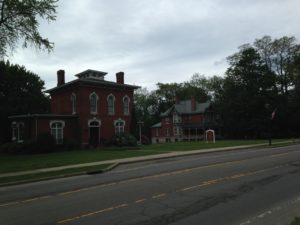
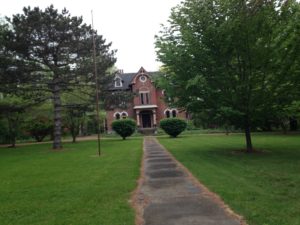 Westfield is a lovely little town with some very nice stately homes. I have no idea what industries might have made this economically feasible – perhaps the Welch factory or the rail line. The town seems to be thriving and is probably pretty busy once the tourist season is in full swing.
Westfield is a lovely little town with some very nice stately homes. I have no idea what industries might have made this economically feasible – perhaps the Welch factory or the rail line. The town seems to be thriving and is probably pretty busy once the tourist season is in full swing.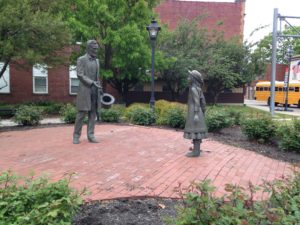
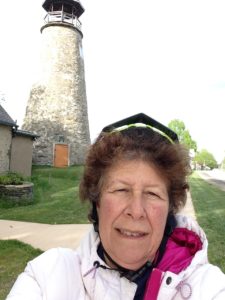 Barcelona is right on the lake and has a scenic lighthouse, as well as a large pier and yacht harbor. The pier is full of gulls, geese and ducks, as well as the occasional eagle. The town itself seems to be tiny, but it has quite a few restaurants.
Barcelona is right on the lake and has a scenic lighthouse, as well as a large pier and yacht harbor. The pier is full of gulls, geese and ducks, as well as the occasional eagle. The town itself seems to be tiny, but it has quite a few restaurants.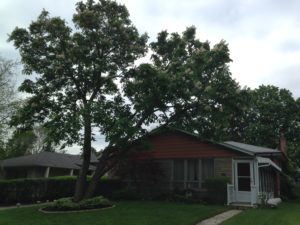 The other tree was a horse chestnut which was planted due to a misunderstanding. As a young child, I had been told that the chestnut trees were all dying due to chestnut blight. I did not understand that this was the American chestnut, not horse chestnut, and so I collected some of the plentiful horse chestnuts that can be picked up in the fall from the trees in downtown Toronto. Several sprouted but only one lived long enough to be put in the garden. It was perhaps 10 feet tall when we moved to Hove – it now towers over the house and my mother complained for years about the plentiful chestnuts it produces, and how the local squirrels dig up her garden to bury them. The gardener trimmed it back severely, which proved lucky a few years ago when a huge ice storm closed Toronto for several days and brought down many trees. But it lost a large limb last winter, and I will not be surprised if the new owners bring it down. (I am pleased to say that a project at Penn State, as well as other US universities, has successfully produced blight resistant American chestnut trees, which will soon be re-introduced to their original habitat.)
The other tree was a horse chestnut which was planted due to a misunderstanding. As a young child, I had been told that the chestnut trees were all dying due to chestnut blight. I did not understand that this was the American chestnut, not horse chestnut, and so I collected some of the plentiful horse chestnuts that can be picked up in the fall from the trees in downtown Toronto. Several sprouted but only one lived long enough to be put in the garden. It was perhaps 10 feet tall when we moved to Hove – it now towers over the house and my mother complained for years about the plentiful chestnuts it produces, and how the local squirrels dig up her garden to bury them. The gardener trimmed it back severely, which proved lucky a few years ago when a huge ice storm closed Toronto for several days and brought down many trees. But it lost a large limb last winter, and I will not be surprised if the new owners bring it down. (I am pleased to say that a project at Penn State, as well as other US universities, has successfully produced blight resistant American chestnut trees, which will soon be re-introduced to their original habitat.)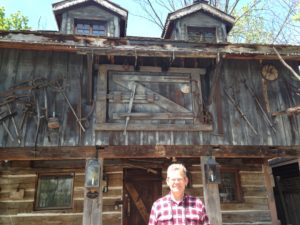 The gallery features the works of a group of famous Canadian painters – Tom Thompson and the Group of Seven. These artists mostly started as Canadian landscape painters, but then brought impressionism to the work. Growing up, I was most interested in Tom Thompson, who painted the northern forests where I spent my summers. (https://en.wikipedia.org/wiki/Tom_Thomson) I found it an almost painful evocation of my childhood to see some of these works, especially Thompson (who is not featured highly in the gallery but whose studio has been moved to the site and is in the photo) and, Lawren Harris, for whom they were having a special exhibit on contemporary artists. (http://www.ago.net/the-idea-of-north-the-paintings-of-lawren-harris)
The gallery features the works of a group of famous Canadian painters – Tom Thompson and the Group of Seven. These artists mostly started as Canadian landscape painters, but then brought impressionism to the work. Growing up, I was most interested in Tom Thompson, who painted the northern forests where I spent my summers. (https://en.wikipedia.org/wiki/Tom_Thomson) I found it an almost painful evocation of my childhood to see some of these works, especially Thompson (who is not featured highly in the gallery but whose studio has been moved to the site and is in the photo) and, Lawren Harris, for whom they were having a special exhibit on contemporary artists. (http://www.ago.net/the-idea-of-north-the-paintings-of-lawren-harris)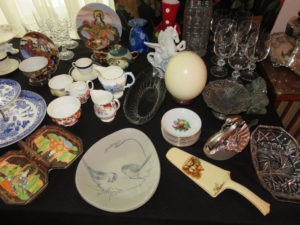 Closing out a house this way is probably the most demoralizing thing most of us will want our kids to do for us. We will want them to do it for two reasons: 1) most of us will prefer to stay in our homes until we die and 2) we hope they will outlive us. In any case, my mother’s house was very full. Firstly, she loved beautiful things and collected them on trips, from catalogues, antiquing with her friends, etc. Secondly, she and my father inherited things, especially china, from their families. (Since most of the family kept kosher, they had meat and milk dishes, cutlery and pots for both ordinary and Passover – 4 sets each.) And finally, while my mother was always happy to give thing away to friends and family, she hated to trash them or give them to garage sales. So unpacking the house is like an archeological dig – dishes I remember from my early childhood, my grandmother’s roasting pan. a photo of my great-great grandfather dressed as a Russian officer (although we are sure that Jews inducted into the csar’s army were the lowest of the low and never officers) as well as cake-plates and serving pieces that she collected. Every one of these reminds me of my mother in some way. But there is only so much room in the house, and my kids, came too late in life to see my mother use most of these items for entertaining, So, it all has to go. These were my mother’s memories, and to some extent my father’s, but they were also mine and it is hard to let them go.
Closing out a house this way is probably the most demoralizing thing most of us will want our kids to do for us. We will want them to do it for two reasons: 1) most of us will prefer to stay in our homes until we die and 2) we hope they will outlive us. In any case, my mother’s house was very full. Firstly, she loved beautiful things and collected them on trips, from catalogues, antiquing with her friends, etc. Secondly, she and my father inherited things, especially china, from their families. (Since most of the family kept kosher, they had meat and milk dishes, cutlery and pots for both ordinary and Passover – 4 sets each.) And finally, while my mother was always happy to give thing away to friends and family, she hated to trash them or give them to garage sales. So unpacking the house is like an archeological dig – dishes I remember from my early childhood, my grandmother’s roasting pan. a photo of my great-great grandfather dressed as a Russian officer (although we are sure that Jews inducted into the csar’s army were the lowest of the low and never officers) as well as cake-plates and serving pieces that she collected. Every one of these reminds me of my mother in some way. But there is only so much room in the house, and my kids, came too late in life to see my mother use most of these items for entertaining, So, it all has to go. These were my mother’s memories, and to some extent my father’s, but they were also mine and it is hard to let them go.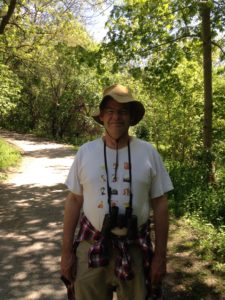 Toronto’s landscape was built by the glaciers of the last ice age. It is built on glacial morraines and cut by deep ravines, with 2 major river systems, the Humber and the Don. Tuesday morning Chuck worked and Tuesday evening I did, but Tuesday afternoon we took a long hike through a park that meanders through the West Don Valley. The park starts about half a kilometer from my mother’s house, so we walked to the park and then took the main trail. It seems that most Torontonians are scofflaws when it comes to leash laws, and Rumple was very happy to join the other hiking dogs off-leash.
Toronto’s landscape was built by the glaciers of the last ice age. It is built on glacial morraines and cut by deep ravines, with 2 major river systems, the Humber and the Don. Tuesday morning Chuck worked and Tuesday evening I did, but Tuesday afternoon we took a long hike through a park that meanders through the West Don Valley. The park starts about half a kilometer from my mother’s house, so we walked to the park and then took the main trail. It seems that most Torontonians are scofflaws when it comes to leash laws, and Rumple was very happy to join the other hiking dogs off-leash.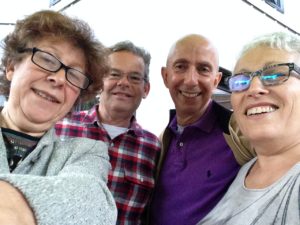 In the evening, we visited our friends Kathy and Salomon, who are recently retired and enjoying lots of travel and cooking. We had the benefit of Salo’s wonderful cooking skills, as well as a long evening walk with their dog and ours.
In the evening, we visited our friends Kathy and Salomon, who are recently retired and enjoying lots of travel and cooking. We had the benefit of Salo’s wonderful cooking skills, as well as a long evening walk with their dog and ours.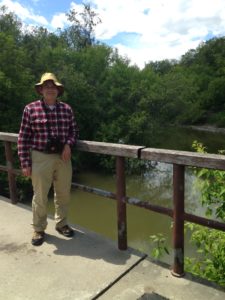
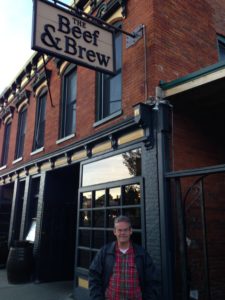
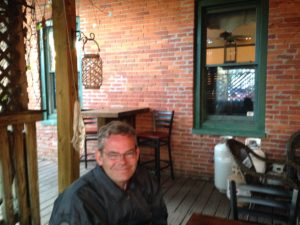
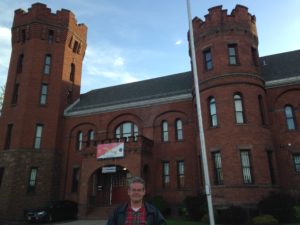 It is a very cute little town. More importantly for our purposes, the Beef and Brew turned out to be a very cute little restaurant with good food. However, since Chuck does not drink beer at all, and I am only a very occasional imbiber, we were not able to fully appreciate the offerings of the brewery. On the other hand, we did appreciate the attitude of the wait staff, who each exhorted us to “enjoy each others’ company” (and we enjoyed the food too).
It is a very cute little town. More importantly for our purposes, the Beef and Brew turned out to be a very cute little restaurant with good food. However, since Chuck does not drink beer at all, and I am only a very occasional imbiber, we were not able to fully appreciate the offerings of the brewery. On the other hand, we did appreciate the attitude of the wait staff, who each exhorted us to “enjoy each others’ company” (and we enjoyed the food too).